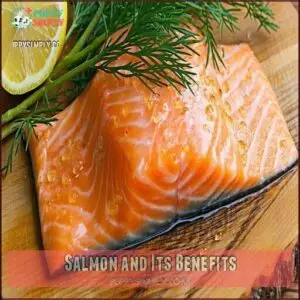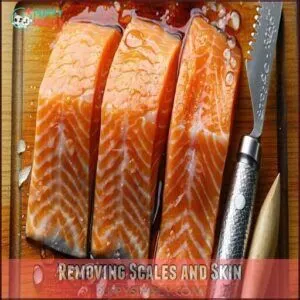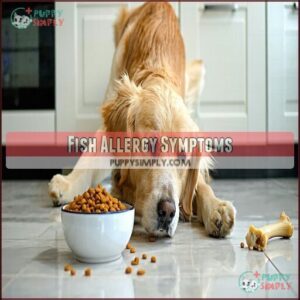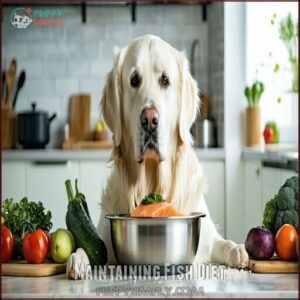This site is supported by our readers. We may earn a commission, at no cost to you, if you purchase through links.
 Yes, dogs can eat fish safely when prepared correctly.
Yes, dogs can eat fish safely when prepared correctly.
Fish provides excellent protein and omega-3 fatty acids that support your dog’s skin, coat, and brain health. Stick to fully cooked, boneless options like salmon, cod, or flounder—think of it as serving up a plate of canine superfood!
Always remove bones, which can be choking hazards or cause internal injuries. Avoid raw fish, which may contain harmful parasites, and skip seasoned fish preparations that might contain toxic ingredients like garlic or onions.
The right fish in your dog’s diet might just be the secret ingredient to keeping their tail wagging for years to come, with benefits including excellent protein, omega-3 fatty acids, and a healthy skin, coat, and brain health.
Table Of Contents
Key Takeaways
- You can safely feed your dog fish when it’s properly cooked, thoroughly deboned, and served without seasonings, oils, or butter.
- Fish provides excellent protein and omega-3 fatty acids that support your dog’s skin, coat, and brain health.
- Choose low-mercury fish like salmon, sardines, cod, and Atlantic mackerel instead of high-mercury options like tuna, swordfish, and king mackerel.
- Limit fish to 10-25% of your dog’s total diet, serving about 1 ounce per 10 pounds of body weight 2-3 times weekly, to maintain a balanced diet.
Benefits of Fish
You’ll find that fish offers remarkable benefits for your dog, including essential proteins and omega-3 fatty acids that support healthy skin and a shiny coat.
Fish also provides a valuable alternative protein source for dogs with food allergies, while delivering important nutrients that support overall development and bodily functions, making it a great option for dogs with specific dietary needs, and offering essential proteins.
Rich Source of Protein
Fish provides one of nature’s best protein alternatives for your dog’s diet.
Fish offers an incredible protein option for your dog, packed with nutrients their body craves.
When dogs eat fish, they’re getting complete protein that supports muscle development and tissue repair just like meat-based options.
- High-quality fish protein contains all essential amino acids your dog needs
- Each serving helps with enzyme production for proper digestion
- Fish protein works double-duty by supporting hormone regulation and immune function
Many commercial dog foods with fish capitalize on these benefits without the common allergies beef can trigger. However, owners should be aware of potential supplement interactions if fish-based diets are combined with other supplements, which can impact hormone regulation and immune function.
Omega-3 Fatty Acids
The omega-3 fatty acids found in fish offer tremendous health benefits for your dog.
These essential nutrients work wonders for reducing inflammation and supporting overall health.
When you add fish to your dog’s diet, you’re providing EPA and DHA—powerful omega-3 types that boost immune function and cognitive development.
Unlike plant sources, fish delivers these fatty acids in their most bioavailable form, making them easier for your pup to absorb and utilize, which can lead to tremendous health benefits.
Healthy Skin and Coat
Through regular consumption of fish, your dog’s skin and coat will transform from dull to dazzling.
Regular fish consumption turns dull pet coats into vibrant, glossy fur that shines with health.
Fish’s omega-3 fatty acids work wonders for canine dermatological health.
The benefits of fish for canine skin health include:
- Reduces excessive shedding by strengthening hair follicles
- Soothes irritated skin caused by allergies or dryness
- Increases coat thickness and shine
- Decreases dandruff and flaking
- Promotes faster healing of minor skin injuries, which can lead to a dazzling coat and improve overall dermatological health.
Can Dogs Eat Fish
Yes, dogs can safely eat fish as part of a balanced diet. Most canines enjoy the distinctive taste of fish while benefiting from its nutritional value.
Fish serves as an excellent protein alternative, especially for pups with sensitivities to chicken or beef. When introducing fish to your dog’s diet, start with small amounts to verify they don’t have adverse reactions.
Fish for dogs should always be properly cooked to eliminate harmful parasites and bacteria. Never serve it with bones, which pose serious choking hazards. You’ll want to keep the preparation simple—avoid oils, butter, salt, or seasonings that could upset your furry friend’s stomach.
The fish health benefits are substantial, but moderation is key. Fish should complement your dog’s regular food rather than replace it entirely. A thoughtful dog fish diet provides variety while maintaining proper nutrition.
Safe Fish Types
You’ll want to choose shorter-lived fish species like salmon, sardines, and whitefish for your dog, as they contain fewer heavy metals and more health benefits.
Longer-lived fish such as tuna and swordfish should be avoided due to their higher mercury levels that can accumulate in your pet’s system over time.
Salmon and Its Benefits
Among all fish options, salmon stands as a nutritional powerhouse for your canine companion.
Wild-caught salmon offers excellent benefits for dogs:
- Rich in omega-3 fatty acids that reduce inflammation
- Contains high-quality protein essential for muscle maintenance
- Provides vitamin B12 supporting neurological function
- Offers nutrients that promote a shiny coat and healthy skin
When preparing salmon for dogs, always cook it thoroughly and remove all bones before serving.
Salmon skin can be beneficial, but consider the risks associated with potential parasite transmission to dogs.
Whitefish as Low-Mercury Option
Whitefish swims to the top of the list when choosing low-mercury fish options for your dog.
These easily digestible varieties support muscle development, heart health, and maintain beautiful coats in your furry friend.
| Whitefish Type | Mercury Level | Benefits for Dogs |
|---|---|---|
| Cod | Very Low | Lean protein, gentle on digestion |
| Haddock | Low | Rich in B vitamins, supports energy |
| Pollock | Minimal | Heart-healthy, good for seniors |
| Tilapia | Negligible | Perfect for sensitive stomachs |
Sardines and Nutritional Value
Sardines pack a nutritional punch for your dog despite their small size.
These tiny fish are loaded with omega-3 fatty acids, vitamins D and B12, and essential minerals.
You can serve them whole since their soft bones are actually beneficial, providing calcium and phosphorus.
As a sustainable seafood choice, sardines offer environmental benefits too.
Just rinse canned varieties to reduce sodium before serving, making them a great choice with essential minerals.
Atlantic Mackerel as Healthy Choice
Atlantic mackerel stands out as a healthy choice for your canine companion.
Unlike larger fish species, it contains lower mercury levels while delivering impressive omega-3 benefits.
When choosing mackerel, opt for Atlantic varieties rather than King mackerel, which can accumulate toxins.
This sustainable fish option provides excellent nutrition for dogs and can be easily incorporated into their diet in appropriate serving sizes, making it a great sustainable fish option.
Fish Preparation Methods
You’ll need to prepare fish properly for your dog to avoid potential hazards like bones and parasites.
Thoroughly cook all fish without seasonings, and always remove bones, scales, and skin before serving to guarantee your pet’s safety.
This process is crucial to prevent harm from parasites.
Grilling and Steaming
Now that you know which fish are safe for your pup, let’s talk about the best ways to prepare them.
Grilling and steaming are excellent cooking methods for preparing healthy fish for dogs while preserving essential nutrients.
Remember that cooked fish skin can offer nutritional benefits.
- Grill fish at a moderate temperature (350°F) for about 5 minutes per side, avoiding seasonings
- Steam smaller fillets for 5-7 minutes to maximize nutrient retention
- Use parchment paper when grilling to prevent sticking without adding oils
Deboning and Filleting
While grilling and steaming cook fish perfectly, proper deboning is non-negotiable for your dog’s safety.
Fish bones pose serious choking hazards and can damage your pup’s digestive tract. Always use sharp filleting tools to completely remove all bones before serving.
Run your fingers along the fillet to identify hidden bones. Many pet owners miss tiny bones during preparation—taking these extra moments could save an emergency vet visit.
To guarantee safe and efficient deboning, consider investing in specialized fish tools.
Removing Scales and Skin
When preparing fish for your four-legged friend, properly removing scales and skin is essential for both safety and digestion.
While fish skin contains beneficial nutrients, you should consider:
- Complete scale removal prevents choking hazards
- Fish skin may contain beneficial collagen for joint health
- Some dogs have allergy concerns with fish skin proteins
- Cooking methods affect skin’s nutritional impact
Always fully cook fish before serving to eliminate parasites.
A fish skin remover can simplify this preparation.
Risks of Feeding Fish
You’ll need to watch out for several health hazards when feeding fish to your dog, including mercury poisoning, parasites, and dangerous bones that can cause choking or internal damage.
While fish offers many benefits, serving it improperly or choosing the wrong varieties can lead to serious health issues that might leave both you and your furry friend feeling anything but reely good.
Mercury Poisoning
While fish offers nutritional benefits for your dog, mercury poisoning is a serious risk when feeding certain species.
Mercury accumulates in fish and can damage your dog’s cardiovascular, pulmonary, and neurological systems.
| Mercury Sources | Poisoning Symptoms | Safe Alternatives |
|---|---|---|
| Tuna (large amounts) | Blindness | Salmon |
| Swordfish | Abnormal behavior | Sardines |
| King mackerel | Lack of coordination | Whitefish |
| Shark | Convulsions | Arctic char |
| Tilefish | Estrogen dominance | Cod |
Parasites and Contamination
While mercury poses serious health concerns, parasites and contamination present another significant risk.
Raw or undercooked fish can harbor dangerous parasites that mature inside your dog after consumption.
Salmon Poisoning Disease, caused by a parasite-bacteria combination in raw or cold-smoked fish, can be fatal without prompt veterinary care.
Symptoms appear 5-7 days after eating contaminated fish and include fever, vomiting, and diarrhea.
Always thoroughly cook fish to kill parasites and bacteria.
Thiaminase and Vitamin B1
Within certain raw fish lurks thiaminase, an enzyme that breaks down essential vitamin B1 (thiamine) in your dog’s body.
This hidden danger exists primarily in tuna, salmon, and shellfish.
Without adequate thiamine, your dog’s energy metabolism suffers.
Cooking fish properly through grilling or steaming deactivates this enzyme, protecting your pup from potentially serious thiamine deficiency.
Always process fish thoroughly before feeding it to maintain peak dog health.
Healthy Fish Options
You’ll find several fish options that provide excellent nutrition for your dog without the risks of mercury or parasites.
Salmon, sardines, and whitefish offer valuable omega-3 fatty acids that support your pet’s skin, coat, and overall health when properly prepared.
Canned Fish Benefits
Canned fish offers your dog a convenient, budget-friendly option packed with nutritional value.
Unlike fresh varieties, properly sealed canned salmon, sardines, and tuna (in water, not oil) provide consistent omega-3 fatty acids without the worry of bones.
Their extended shelf life makes storage tips simple—keep unopened cans in your pantry for up to two years.
Consider canned salmon options for your canine.
When shopping for dog food with fish, check labels for these nutritious ingredients to boost your pup’s health and ensure you’re providing the best possible nutritional value with canned fish.
Raw Fish Risks
While canned fish offers convenience, feeding raw fish to your dog comes with significant dangers.
Raw fish can harbor bacterial contamination from salmonella and listeria, potentially causing severe food poisoning.
Your furry friend may also face parasite exposure through uncooked seafood.
Additionally, certain raw fish contain the thiaminase enzyme, which destroys vitamin B1, and mercury concerns remain prevalent.
Serving raw fish to dogs simply isn’t worth these serious health risks.
Cooked Fish Benefits
Properly cooked fish offers a treasure trove of health benefits for your furry friend.
The cooking process substantially improves digestibility while maintaining nutrient retention and enhancing palatability.
When preparing cooked fish for dogs, remember these key advantages:
- Eliminates harmful bacteria and parasites that raw fish might contain
- Preserves essential proteins and nutrients dogs need
- Makes the natural oils and omega-3s more bioavailable
Fish Allergy Symptoms
You’ll need to watch for signs like itching, swelling, or digestive upset if your dog has a fish allergy.
These symptoms typically appear within minutes to hours after consumption and may require immediate veterinary attention.
Signs of Allergic Reaction
Watching your dog scratch constantly after eating fish could signal a food allergy.
Common signs include skin irritation, facial swelling, gastrointestinal upset, and in severe cases, breathing difficulties.
You might also notice chronic ear infections, excessive paw licking, or hair loss.
If you suspect fish allergies in your dog, track symptoms after meals and consult your veterinarian for proper diagnosis and treatment options.
Hypoallergenic Food Options
If your dog shows signs of fish allergies, you’ll need hypoallergenic food options.
Products like Royal Canin Hydrolyzed Protein and Purina Pro Plan HA offer novel proteins that minimize allergic reactions.
Look for limited ingredient diets such as Natural Balance or Purina’s Sensitive Skin formula.
Just Food for Dogs Joint & Skin Support can also help.
Limited-ingredient diets reduce allergens in sensitive pups.
These specialized formulas work by eliminating common allergens while providing complete nutrition during elimination trials.
Consulting a Veterinarian
If your dog shows signs of fish allergies, consulting a veterinarian should be your next step.
They’ll provide an individual assessment based on your dog’s specific needs and breed predispositions.
- Vets can recommend appropriate dietary changes that address allergies
- They’ll evaluate if your dog needs specialized pet health monitoring
- A veterinary nutritionist can create a custom dog nutrition plan
- Professional advice guarantees proper supplementation without compromising dog diet balance
Feeding Fish to Dogs
You’ll find fish provides valuable protein and omega-3 fatty acids that can improve your dog’s coat and overall health.
When feeding fish to your dog, always remove bones and cook it thoroughly without seasonings to prevent potential risks.
Nutritional Benefits for Dogs
Fish offers your dog more than just a tasty meal.
After identifying allergies, understanding fish’s nutritional value helps you make informed feeding choices.
| Nutrient | Benefit | Best Fish Source |
|---|---|---|
| Protein | Muscle development | Salmon, Cod |
| Omega-3 | Joint support & cognitive function | Sardines, Mackerel |
| DHA | Brain health | Salmon, Trout |
| Vitamin D | Bone strength | Tuna (limited amounts) |
These nutrients make fish an excellent protein source that supports coat health while providing essential omega-3 fatty acids for your dog’s overall wellbeing.
Monitoring Health Effects
After introducing fish to your pup’s diet, keep an eye out for these telltale signs of how they’re adjusting:
- Skin irritation or excessive scratching (possible fish allergies)
- Significant weight fluctuations up or down
- Changes in stool consistency or energy levels
- Dullness or improvement in coat condition
Watch closely during the first week, as reactions to omega-3 or potential contaminants typically appear quickly.
Don’t hesitate to contact your vet if something seems off.
Portion Sizes and Frequency
A balanced plate guarantees your dog gets just the right amount of fish without overdoing it.
Serve 1 ounce of cooked, deboned fish per 10 pounds of body weight, 2-3 times weekly.
| Dog Size | Daily Fish Intake | Weekly Fish Limit |
|---|---|---|
| Small (10 lbs) | 1-2 tablespoons | 3-4 tablespoons |
| Medium (30 lbs) | 3 ounces | 6-9 ounces |
| Large (60+ lbs) | 6 ounces | 12-18 ounces |
Start with smaller portions to check tolerance first, ensuring a healthy diet for your dog.
Maintaining Fish Diet
You’ll need to balance fish with other protein sources in your dog’s diet to maintain ideal nutrition without overfeeding.
When adding fish to your pet’s meal plan, start with small portions twice weekly and adjust based on your dog’s size, health needs, and veterinarian recommendations.
Balancing Fish With Other Foods
Now that you’ve introduced fish to your pup’s menu, let’s talk about creating dietary harmony.
While fish provides excellent omega-3 fatty acids and protein, it shouldn’t swim solo in your dog’s bowl.
Aim for nutrient completeness by rotating different proteins throughout the week.
Mix quality dog food with appropriate fish portions to maintain calorie control and guarantee your puppy nutrition stays balanced without overrelying on a single protein source.
Adjusting Fish Consumption
Once you’ve established fish in your dog’s diet, you’ll need to fine-tune portions based on several factors.
Here’s how to adjust your dog’s fish consumption:
- Monitor weight changes and adjust portion size accordingly
- Consider breed differences – larger breeds may tolerate more fish
- Factor in activity level – active dogs can process more protein
- Adapt to age consideration – puppies and seniors have different needs
- Watch for allergic reactions requiring dietary balance adjustments
To ensure a healthy diet, it’s crucial to follow these steps carefully and be aware of your dog’s specific needs, making adjustments as necessary to maintain a balanced nutrition plan.
Consulting a Veterinarian for Advice
Always consult your veterinarian before making significant dietary changes that include fish in your dog’s diet.
They’ll consider your pet’s unique health profile when offering guidance.
| Consultation Topic | Why It’s Important |
|---|---|
| Breed Predispositions | Some breeds have specific nutritional needs |
| Fish Allergies | Identifying symptoms and safe alternatives |
| Supplement Needs | Determining if additional nutrients are required |
| Personalized Diet | Tailoring fish portions to your dog’s size/health |
| Safe Fish Options | Advice on best varieties for your specific dog |
The table outlines key consultation topics to discuss with your veterinarian, ensuring you cover all necessary aspects for your dog’s dietary needs.
Fish Serving Guidelines
You’ll need to follow specific guidelines when serving fish to your dog to guarantee safety and proper nutrition.
Proper portion control, thorough deboning, and maintaining fish as just one part of a balanced diet will help your canine companion enjoy the benefits without any health risks.
This approach ensures your dog can benefit from fish while minimizing potential health risks.
Avoiding Overfeeding
Moderation is key when feeding dogs fish. Your pup’s portion control should account for their size, age, and activity level – a teaspoon for small breeds and up to a tablespoon for larger dogs is sufficient.
Include these calories in your daily calorie calculation to prevent weight gain. Monitor your dog’s weight regularly when incorporating fish into their diet.
Remember that fish should only comprise 10% of their total food intake.
Balanced Diet With Fish
Fish should complement—not replace—your dog’s regular diet.
When creating a balanced diet with fish, remember to:
- Mix fish with other protein sources like chicken or beef for complete amino acid profiles
- Include carbohydrates and vegetables alongside fish to provide diverse nutrients
- Limit fish to 10-25% of their total diet to prevent nutrient imbalances
This approach guarantees your pup gets omega-3 benefits without sacrificing diet variety or complete nutrition.
Fish as Occasional Treat
While your balanced diet should always come first, treating your dog to fish occasionally adds nutritional variety.
Consider fish as a special reward rather than a daily staple.
Here’s a quick guide to fish treats for your furry friend:
| Treat Type | Frequency | Portion Size |
|---|---|---|
| Fish Skin | Weekly | 1-2 small pieces |
| Cooked Salmon | Bi-weekly | 1 tbsp per 10 lbs |
| Sardines | Weekly | 1 small sardine |
| Whitefish | Bi-weekly | 1 tbsp per 15 lbs |
Frequently Asked Questions (FAQs)
Can dogs eat fish meat?
Like a treasure trove for their nutrition, fish is perfectly safe and healthy for your dog to eat.
It’s rich in omega-3 fatty acids that’ll benefit their coat and skin health.
Is it good to eat fish?
Yes, enjoying fish offers excellent nutrition with abundant omega-3 fatty acids that support your heart health.
You’ll benefit from high-quality protein, essential vitamins, and minerals while keeping your diet diverse and flavorful.
Can pets eat fish?
Just as sailors rely on fish for sustenance at sea, your furry friends can enjoy fish too.
Yes, pets like dogs and cats can eat properly prepared fish, providing them with valuable protein and omega-3 fatty acids.
Can puppies eat fish?
Puppies can eat well-cooked, boneless fish as a nutritional protein source.
You’ll want to introduce it gradually after weaning, ensuring it’s fully deboned and unseasoned to avoid digestive upset or choking hazards.
Can dogs eat wild caught fish?
Just as many pet parents enjoy seafood, your dog can safely eat wild-caught fish.
You’ll want to cook it thoroughly, remove all bones, and avoid species with high mercury content like tuna or swordfish.
Can dogs eat raw fish?
No, dogs shouldn’t eat raw fish.
It can contain harmful bacteria like salmonella and parasites that may make your dog sick.
Always cook fish thoroughly before serving it to your furry friend.
Can dogs eat cooked fish?
Like a fish to water, your pup can safely enjoy cooked fish.
It’s a healthy protein source that’s rich in omega-3 fatty acids.
Just make certain it’s fully cooked, boneless, and free of seasonings.
Is fish in dog food better than meat?
Neither is inherently "better" – both fish and meat provide protein for your dog.
Fish offers omega-3 fatty acids and can be ideal for dogs with allergies, while meats like chicken provide different nutritional benefits.
Can a dog get sick if they eat fish food?
Yes, your dog can get sick from eating fish food. It’s not toxic but contains ingredients unsuitable for canines that may cause digestive upset, including vomiting and diarrhea.
Will fish food harm a dog?
Fish food typically won’t seriously harm your dog, but it can cause digestive upset like vomiting or diarrhea.
It’s not toxic, but it’s not designed for canine consumption, so keep it out of reach.
Conclusion
When Rob’s Labrador had skin problems, adding fish to his diet transformed his coat within weeks.
Remember, can dogs eat fish? Absolutely—when prepared properly.
By serving boneless, fully cooked fish in appropriate portions, you’re providing excellent nutrition while avoiding potential hazards.
Whether you choose salmon for omega-3s or whitefish for its low mercury content, your furry friend will benefit from the protein and nutrients.
Just keep it simple, monitor for allergies, and watch that tail wag!




















